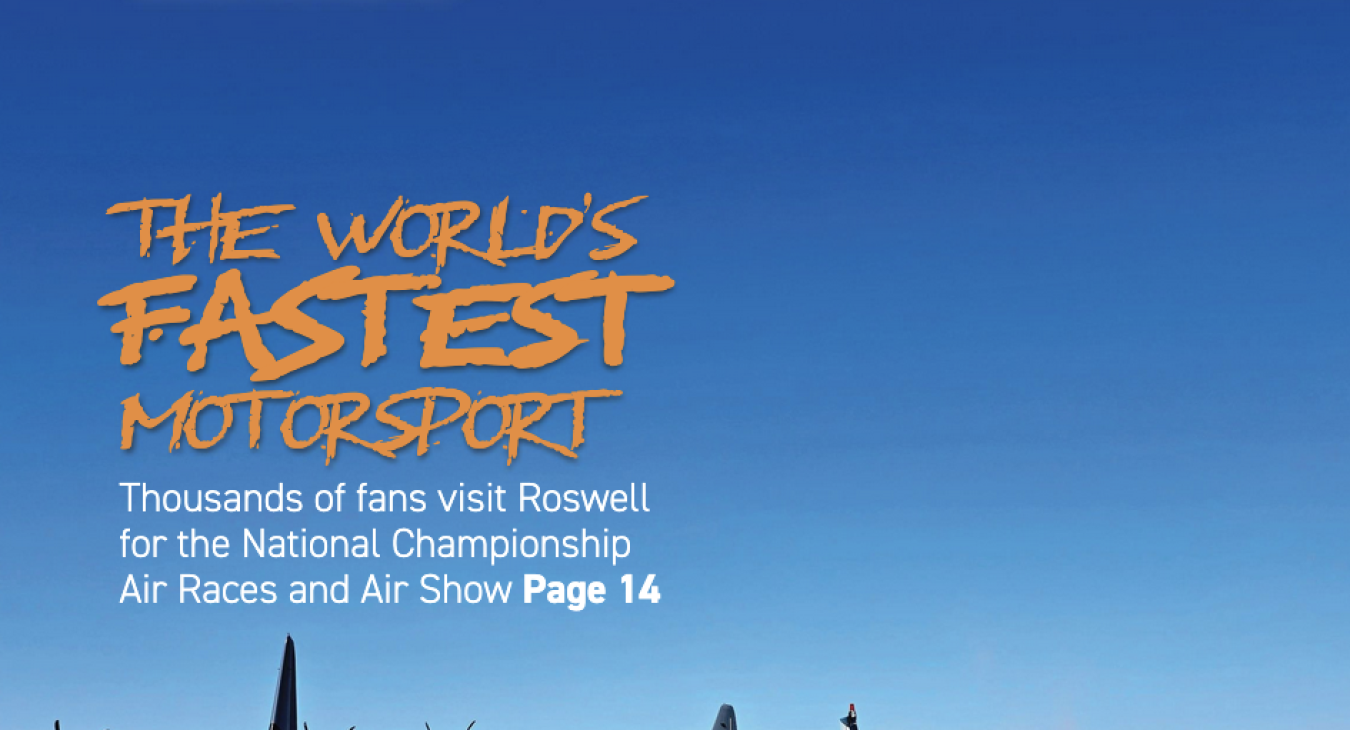The World's Fastest Motorsport
By Chris Eboch
On a warm week in September, thousands of flight fans flocked to Roswell for the National Championship Air Races and Air Show.
Like NASCAR in the sky, air races see small aircraft fly laps along a roughly circular course marked by 50-foot-high poles. Up to eight planes race at one time, jockeying for the lead at hundreds of miles per hour. They fly mere dozens of feet above the ground, passing by the audience in each of five laps.
From Sept. 10–14, the races and air show brought thousands of visitors to Roswell to wander through displays and watch the races. This year, some 60,000 tickets were sold, and Roswell hotels sold out for the weekend.
Air races date back to the period after World War I, when military teams competed. The sport has adapted into a challenging competition where pilots build and modify their craft for speed.
Starting in 1964, the National Championship Air Races were held outside of Reno. The event grew to attract more than a million spectators, bringing an estimated economic impact of more than $100 million.
After the 2023 season, the Reno Air Racing Association was searching for a new home. Reno was growing and encroaching on the airfield, presenting safety issues. Nearly 40 locations showed interest in being the new host city, and six submitted full proposals and committed to at least $10 million in investments to prepare the sites. RARA spent a year comparing space, logistics, security, and safety.
In the end, Roswell’s bid was deemed the best, and the National Championship Air Races filed a flight path to New Mexico. The site has an agreement with RARA to host the races for at least 30 years.
“The commitment and investment from the state of New Mexico and the city of Roswell to preparing the site and helping us to market the event for future growth was significant,” says Tony Logoteta, president and chief operating officer of RARA.
The new home of the air races includes Roswell Air Center Airport and Brown Brothers Ranch, owned by the Hollifield family. The airport, built in the 1940s, served as an Army Air Corps base during World War II. It later became Walker Air Force Base, served as a launch site for stratospheric research balloons, and was mentioned in the 1947 Roswell incident with a suspected UFO. Now converted for civilian use, it hosts daily commercial flights to Dallas–Fort Worth International Airport.
The site underwent renovations to prepare to host the air races. Roughly 80 acres of dirt were paved over. Power lines across the course were buried while other nearby poles had marker balls added to make them more visible.
All the work and investment paid off. On the event’s opening weekdays, buses delivered hundreds of students who took in a science, technology, engineering, and mathematics discovery zone offering displays and activities. Students and other visitors learned engineering and aerodynamics principles and explored robotics, drone technology, and flight simulators with high-tech gadgets.
The event had a party atmosphere, with some people staying on-site—the location has 200 RV parking spots with power and water. When storms delayed some of the Saturday races, fans explored the air show, which featured planes ranging from a military fighter to FiFi, a restored B-29 bomber flown during World War II and the Korean War. Inside hangars, visitors saw small airplanes and talked with the owners. In between races, musicians performed and pilots showed off aerobatic flying stunts.
Five classes raced this year. In the future, visitors should also see two additional classes, and the U.S. Air Force Thunderbirds will headline the 2026 show.
As the air races grow, who knows what surprises they will bring to Roswell. Several celebrities visited the Reno air races, including Harrison Ford, John Travolta, and Tom Cruise. Past years have seen a flyby from a World War I canvas plane and the demo of a one-person experimental helicopter that looks like a flying tricycle.
Reporters, photographers, and volunteers who came to the Roswell races talked about getting hooked on the first air race they ever saw. One volunteer said he “raised his family” at the Reno air races after inheriting a box ticket from his grandfather. With a new home in Roswell, the National Championship Air Races and Air Show organizers hope local and visiting families can have the same experience for years to come.
Shooting Through the Skies
The 2025 National Championship Air Races featured five racing classes:
Formula One — This class uses aircraft with a 100-horsepower engine, similar to what is in a two-seat Cessna 150.
Winner: Josh Watson, in Fraed Naught.
Speed: 251 mph. Time: 06:05.803.
Biplane — The biplane class has small, aerobatic aircraft with two pairs of wings.
Winner: Tom Marden, in Second Hand.
Speed: 220 mph. Time: 05:13.416.
T-6 — This class features racing between specific types of stock aircraft, including the T-6 “Texan,” a single-engine plane used to train pilots during World War II. Because the aircraft are all the same type, strategy and pilot skill matter more than the plane itself.
Winner: Chris Lefave, in Midnight Miss III.
Speed: 238 mph. Time: 08:09.709.
Jet — The jet class is the fastest motorsport in the world.
Winner: Bob McCormack, in Athena.
Speed: 483 mph. Time: 07:40.
STOL — Drag racers fly about 2,000 feet in each direction on a straight track, landing on or after a white chalk line with a complete stop between runs.
Winner: Steve Henry.*
Average run time: 53.96 seconds. Fastest run: 53.41 seconds.
Those who visited the races and air show could walk up to the competing planes, as well as a collection of historic aircraft.


